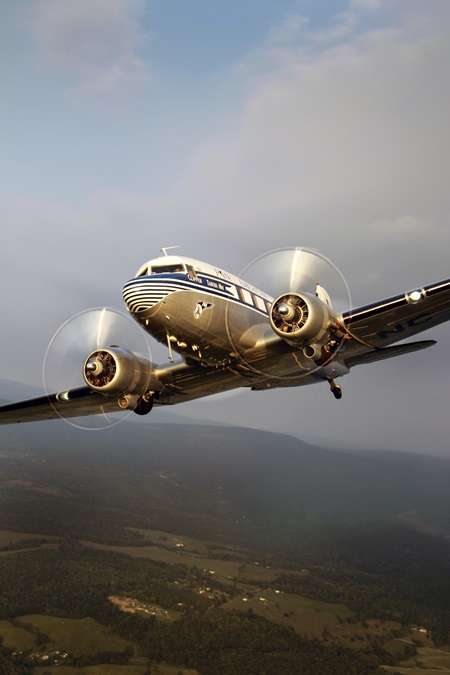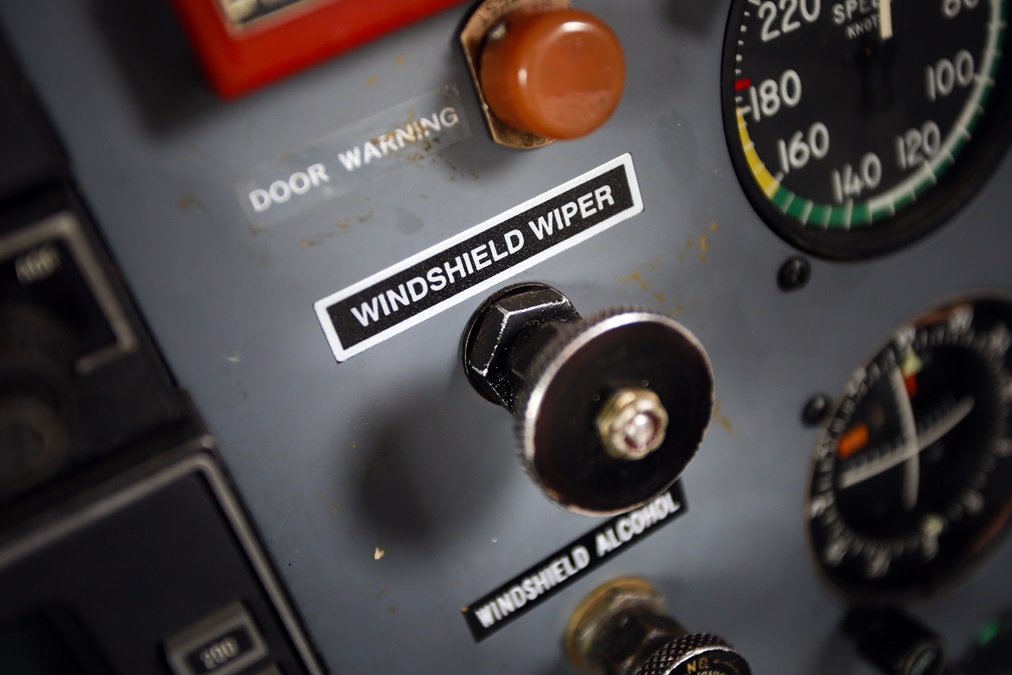Golden age ambassador
Clipper 'Tabitha May's' journey
Clipper Tabitha May, a 1945 DC–3C painted in postwar Pan American Airways livery, still works as a unique corporate barge—but mostly serves as an ambassador to a bygone era of early air travel. Since its 2013 (re)debut from a second extensive restoration, the aircraft has made many appearances at airshows, as well as regional and local fly-ins. The Clipper is also a business airplane for PMDG Simulations, a software company that produces simulations of several airline types for use on a personal computer. Taxiing up to the FBO in a vintage DC–3, versus a King Air or Citation, goes a long way in making a lasting impression on PMDG’s clients.
For the ambassador appearances, the Clipper’s crew arrives in full Pan Am pilot uniforms, including the unmistakable white caps. Especially at smaller gatherings, the towering Clipper becomes the star of the show. The DC–3’s art deco design remains timeless. Its huge, tapering wings; high nose; and unmistakable sound continue to turn heads 80 years after the model first flew.
The iconic DC–3, dating to 1935, possesses among the best payload/efficiency numbers ever met in a commercial airplane design. So good were the numbers that the military also pressed them into duty as a sort of jack-of-all-trades airplane known as the C–47, R4D, Skytrain, and Dakota—depending on the branch or nation. Modified with a strengthened floor and huge entry door, the C–47 was a troop transport, glider towplane, VIP aircraft, and “Hump” hauler. It played a crucial part in the Allied victory of World War II and in postwar duties as well, most famously in the Berlin Airlift.
While the DC–3 may be old and use comparatively cantankerous radial engines, it is still an economical, viable airplane. No competing airplane can do what the DC–3 can do for the money. Other aircraft are either too small, too big, can’t carry the weight and/or volume, can’t use short/unprepared runways, burn too much fuel, or simply cost too much.
Robert Randazzo, PMDG’s founder, is the reason the Clipper is where it is today, in its fully restored condition. “I have always loved the DC–3 and I’m surrounded by enablers,” said Randazzo. The long story starts with Randazzo’s introduction to fellow DC–3 owner Clay Lacy while at the 2009 Reno air races. “[Lacy] enthusiastically supported the idea and assured me that DC–3 ownership, while not for the faint of heart, was not nearly as crazy as it might have seemed to me at the time.” Randazzo also spent time mulling it over with his family and friends. “Surprisingly, not one of them made even a token effort to talk me out of the idea.”
With approval in hand, Randazzo enlisted Bill Muszala of ATW Aviation to seek out a viable candidate airframe, specifically one that could easily be reconditioned to a corporate configuration. Muszala and Randazzo focused on a former C–47 that was converted to a DC–3 by a previous owner. It had been for sale for eight years and was occupying ramp space in Rockford, Illinois. The pair spent two days picking through the airframe and were encouraged by its condition. Basler Aviation, the Oshkosh, Wisconsin, outfit perhaps best known for converting DC–3s to turbine power, had largely rebuilt the airplane in 1991 in preparation for Part 121 airline service at Era Alaska. And while at Era the airplane was flown and maintained with regularity.
“We found no corrosion and her systems were largely in perfect working order,” said Randazzo. “She was very much in need of some catch-up maintenance, but she would need very little compared to the rebuilding required by many other aircraft on the market.” Randazzo acquired the airplane in September 2011 and it was flown to ATW’s Marana, Arizona, shop to start the restoration.
Randazzo equates maintenance on the Clipper to painting the Golden Gate bridge: “It takes two years, and then we start again at the beginning.”Like most DC–3s, Clipper Tabitha May has a storied past. It was manufactured in Oklahoma City and delivered to the U.S. Army Air Corps as a C–47B-50-DK in October 1945 as a VIP transport. When the war ended, it was immediately turned over to the Reconstruction Finance Corporation, which sold it to Garrett AirResearch for conversion to a model DC–3C. It served as a corporate aircraft for CBS and Outboard and Marine Manufacturing, then was used to conduct tours over the Grand Canyon. In 1978, the Experimental Aircraft Association purchased it and used it for flights similar to those the association performs with its B–17 Aluminum Overcast today. After EAA, the DC–3 went across the airport to Basler for its restoration for Era Alaska. It was retired from passenger service at Era in 2003 because it would cost too much to install a breach-proof cockpit door, which was mandated that year for Part 121 carriers.
Key to any aircraft restoration project is an expert in the type—and for this project, Muszala was the guy. “We elected to rebuild every major system on the airplane in order to prevent surprises,” said Randazzo. But like any restoration, surprises are inevitable. Both right fuel tanks had hard-to-trace leaks, and a lengthy game of “follow your nose” discovered the culprits. In 2012, the Clipper suffered an engine failure on the ferry flight from the paint shop to Reno for a planned engine change. Naturally, the engine that failed was not the engine to be changed, so a surprise double engine overhaul had the DC–3 calling Ogden, Utah, home for a spell.
In all, it was two years of careful planning and painstaking work to bring the Clipper to its current glory. To cap off the restoration, Randazzo named his DC–3 after his daughter. Clipper Tabitha May now resides at the Manassas (Virginia) Regional Airport. Randazzo’s crew of trusted pilots, friends, and technicians bring a unique set of operating skills to the team. It is a labor of love to care for an aged airliner. Spare parts availability is an issue, so it’s important to constantly be on the lookout for certain consumables, said Randazzo. “Shortages will occasionally develop for certain parts, and the key to survival is to have them on hand before you think you will need them.”
A former airline pilot himself, Randazzo and his pilots fly the Clipper by the numbers. “It’s marvelously rewarding to fly if you stick to your numbers,” Randazzo said. “If you try to get creative on the approach, for example, she will abuse you all the way to and through the landing.”
Mixture management of the Pratt & Whitney radials is largely automatic and similar to FADEC systems on modern turbines. Mixtures have positions for Rich, Lean, and Cutoff. Takeoff and climb are in Rich mode. Cruise and descent are in Lean. It’s a mostly hands-off system that was well ahead of its time.
Cruise speed is 160 KTAS, burning a total of 110 gallons of avgas per hour. With 820 gallons of usable fuel, range can top out at 1,100 nautical miles. Oil capacity is 58 gallons and the Clipper uses about a gallon per hour in both engines.
The Clipper is on an FAA-approved phased inspection plan, broken down into four required inspections based on flight time and/or calendar time—similar to maintenance for a business jet. Randazzo equates it to painting the Golden Gate bridge: “It takes two years, and then we start again at the beginning.” Muszala remains key to the Clipper’s continued care.
Crewmembers use operational logs for every flight, noting oil pressure, temperatures, fuel flow, rpm, et cetera. “We note every wiggle of a needle, vibration change, or oil appearing in a place not previously seen,” said Randazzo. “Our goal is to be certain that Bill is aware of every nuance and change in behavior so that he can adequately plan our maintenance and inspection cycles, and prevent unexpected problems.” Since emerging from the restoration more than three years ago, the Clipper has had only one cancellation for maintenance-related issues, and one inflight diversion because of a failing prop governor.
While Tabitha May made a homecoming return of sorts at EAA AirVenture in July 2016, the airplane usually can be found at local/regional airshows helping to ignite an interest in aviation and flight simulation. Many of today’s older pilots were influenced by their first airline flight in a DC–3 decades ago. Randazzo hopes that magic will inspire a new generation’s interest in aviation.
“Every one of us has had the experience of seeing something truly breathtaking land at a local airshow, and it never gets old being the team that brings that airplane to town,” said Randazzo. In 2019, the Clipper will be flown to Europe to participate in the seventy-fifth anniversary of D-Day, the success of which hinged largely on the C–47. Randazzo also plans to fly the Clipper on the 100th anniversary of the DC–3 in 2035, and the Clipper Tabitha May’s 100th birthday in 2045. And of course, Randazzo says, all the adventures in between.












